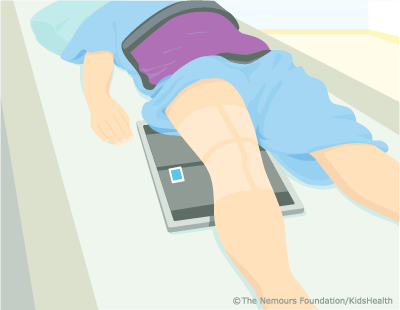X-Ray Exam: Knee
What's an X-Ray?
An X-ray is a safe and painless test that uses a small amount of radiation to make an image of bones, organs, and other parts of the body.
The X-ray image is black and white. Dense body parts, such as bones, block the passage of the X-ray beam through the body. These look white on the X-ray image. Softer body tissues, such as the skin and muscles, allow the X-ray beams to pass through them. They look darker on the image.
X-rays are commonly done in doctors’ offices, radiology departments, imaging centers, and dentists’ offices.
What's a Knee X-Ray?
In a knee X-ray, an X-ray machine sends a beam of radiation through the knee, and an image is recorded on a computer or special film. This image shows parts of the bones of the knee, including the femur (the bone above the knee), the tibia and fibula (the lower leg bones), the patella (kneecap), and the soft tissues.
An X-ray technician will take pictures of the knee:
- from the front (anteroposterior view or AP)
- from the side (lateral view)
- when the knee is bent (sunrise view of the kneecap)
Occasionally, doctors also order an X-ray of the opposite knee for comparison. Sometimes, other picture views also might be done.
Knee X-rays are done with a child standing or lying down on a table. They should stay still for 2–3 seconds while each X-ray is taken so the images are clear. If an image is blurred, the X-ray technician might take another one.

Why Are Knee X-Rays Done?
A knee X-ray can help find the cause of pain, tenderness, swelling, or deformity of the knee. It can show broken bones or a dislocated joint. After a broken bone has been set, an X-ray can show if the bones are aligned and if they have healed properly.
An X-ray can help doctors plan surgery, when needed, and check the results after it. It also can help to diagnose later stages of infection, as well as cysts, tumors, or other diseases in the bone.
What if I Have Questions?
If you have questions about the knee X-ray or what the results mean, talk to your doctor.


